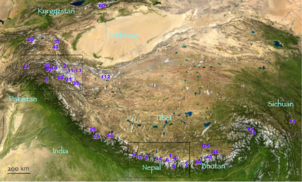| Muztagh Ata | |
|---|---|
| مۇزتاغ ئاتا (Uyghur) مۇزتوو آتا (Kyrgyz) མུཛ་ཏག་རི་རྩེ། (Standard Tibetan) 慕士塔格峰 (Chinese) | |
 Muztagh Ata, as viewed from the Karakoram Highway | |
| Highest point | |
| Elevation | 7,546 m (24,757 ft)[1][2] Ranked 49th |
| Prominence | 2,698 m (8,852 ft)[1] |
| Listing | Ultra |
| Coordinates | 38°16′42″N 75°06′57″E / 38.27833°N 75.11583°E[1] |
| Naming | |
| English translation | Father of ice mountains |
| Language of name | Uyghur |
| Geography | |
| Location | Xinjiang, China |
| Parent range | Pamir Range |
| Climbing | |
| First ascent | 1956 by E. A. Beletskiy et al. |
| Easiest route | Glacier/snow climb |

Muztagh Ata (meaning 'Iceberg Father' in English), formerly known as Mount Tagharma and Wi-tagh, is the second highest of the mountains which form the northern edge of the Tibetan Plateau, with an elevation of 7,546 m (24,757 ft).[2] It is sometimes regarded as being part of the Kunlun Mountains, although physically it is more closely connected to the Pamirs. It is also one of the relatively easier 7,000 m peaks in the world to climb, due to its gentle western slope and the comparatively drier weather of Xinjiang, though a thorough acclimatization period and a very strong physical condition are crucial for success.
- ^ a b c "China II: Sinkiang – Xinjiang". Peaklist.org. Retrieved 26 May 2014.
- ^ a b Note: The footnote in this source states: "The frequently cited 7546m elevation should be replaced by the newer 7509m elevation that appears on Chinese maps, and is more compatible with SRTM." "China II: Sinkiang – Xinjiang". Footnote#9. Peaklist.org. Retrieved 26 May 2014.
